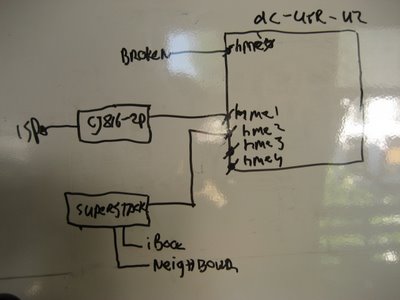For about 6 months now, I've been running solaris 10 at home as my primary server. I've got a bundle of all SUN/sparc branded hardware from the stone ages, which I try to utilize as much as possible, and ever since I threw my ISP provided Copper Jet 816-2p against the wall and swore never ever again to use it as something more than just a dumb modem (yes I know, it *can* be
setup as a router, I've done that and cursed it every time it hung for some unknown reason) I've been struggling to set my Ultra 2 up as a proper replacement.
It was about time however that I started documenting my struggles as I think I've come a long way since I started out configuring and my guess is I'll never be able to reconfigure it like that again. (my OS grows organically).
As an overview, I think a diagram is always useful, but since I loathe diagram drawing software (or any graphics stuff for that matter), I put my white board & brand new camerato good use:

[ note: I got it wrong here: hme2 is attached to the copperjet. and hme1 is connected to the hub ]
Yup. I know. handwriting and drawing is not my thing either (this explains as well my craze for anything with a keyboard attached). For the record: the copperjet is attached to the hme1 and a very old 3Com superstackII 24 port hub is attached to hme2.
the cursed copperjetThe copperjet comes factory configured with an ip-address of 172.19.3.1/16 but for now, that's not really relevant since it's in bridging mode.
superstack hub
I can't exactly say why, but the superstack hub and I have had a loving relationship ever since I found and bought it at a flea market for about 5 euros. There's simply something magical about being able to observe and manage your network. It's not really fancy, since managing is limited to switching ports off and on, but a mighty fine set of ethernet statistics is gathered round the clock. Simply wonderful despite all it's shortcomings (i.e. 10 MBit, half duplex, and not being a switch). A long time ago, when I was still running a 10.0.0.0/8 network at home, I assigned it an address of 10.0.1.3/8 which I'll leave like that for now.
The clientsTalk about overkill: I've got two clients semi-permanent clients in my network! one is my primary interface to the net: my faithul iBook G4, the other one is my upstairs neighbour. The flat above me is apparently some kind of company owned flat where they put up all their international trainees. So every six months or so, a new trainee from (usually) France settles in. It's not that I mind helping them get around in the Netherlands, but we tend to go through the same cycles... "Can you help me set up my internet?" etc etc. I even ended up in assisting them to talk to some of the ADSL and cable-internet providers... Every six months or so, for about two years. So I decided to make life easy for myself and just connect her onto my pretty fat ADSL wire.
The servermy faithful Ultra 2! what a beauty she is! Such stability! So much perseverance when faced with adversity! We go a long way back, my Ultra 2 and me... I got her about 3 years ago, when I traded my Ultra 10 for her. I've lovingly upgraded her since, with 2x 18GB disks, a HVD scsi card, a SE scsi card, a quad ethernet card, additional external disks, and finally: 2x400MHz ultra sparc II procs which enabled me to run solaris 10, without dirty hacks to get it running.
The latest addition is a 7 slot DLT4000 autoloader, which I intend to use for the incidental backup.



